Galway History Facts and Timeline
(Galway, County Galway, Ireland)
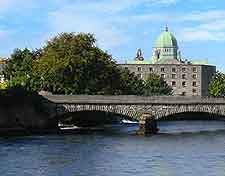
The history of Galway can be traced back to neolithic times. Recent archaeological finds suggest that there has been human settlement on the site since then. It's also known that there has been a fort or 'dun' here since earliest times.
Galway's name is thought to derive from the River Galway, with 'Gailimh' being its Irish name. In the 10th century, the Vikings raided many settlements in the area, although it's unlikely that they set up a permanent settlement here.
The Medieval Era
The 12th century was a time of frequent clan warfare in the area. In 1124, the O'Connor clan built a fort at the mouth of the river. Then, in 1132, the fort fell into the hands of a rival clan. Evidence of port activities in Galway can be dated to this period and surviving records tell of ships leaving the fort in 1154. In 1235, the Normans invaded and captured the fort under the leadership of Richard de Burgo. Two decades later, a wall was built to enclose the town of Galway and its castle.
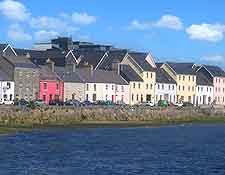
During the Middle Ages, Galway grew and prospered. In 1320, St. Nicholas Church was erected as its parish church. Stronger defensive walls were added at this time too. A series of charters were granted to the town, which was now also permitted to mint coins. As the years passed, Anglo-Norman culture and power dwindled and native Irish influence grew. By the 15th century, a core of Irish families - some 14 in all, had come to dominate the town's political life. Known as the Tribes of Galway, they also controlled much of the trade that took place here.
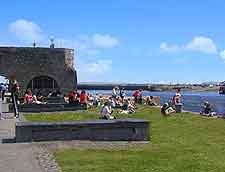
History from the 16th to the 18th Century
In the 16th century, the Augustinian religious community built their first convent on Fort Hill. The strategic importance of the hill was particularly relevant at that time, as there were constant fears of Spanish invasion. These led to the convent's eventual fortification and a drawbridge entrance was also built. Such threats aside, Galway expanded as a trading centre. Imports included fruit, oil and wine, mainly from
Spain. The town's principal exports at this time were fish, leather and wool. Galway also acquired its own hospital, known as St. Brigid's, as well as a gaol.
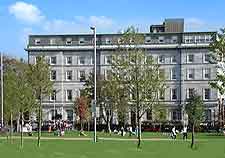
Such relative peace and prosperity was to be interrupted during the 17th century. From 1651 to 1652, the town came under a long siege. For those trapped within the town, life was hard, with food supplies running low and disease rife. When the townsfolk were eventually made to surrender, its Catholic inhabitants were forced to move out. Galway's most powerful families lost their grand town houses and, in terms of influence, became a shadow of their former selves. It was to take another century to claw back the town's lost wealth.
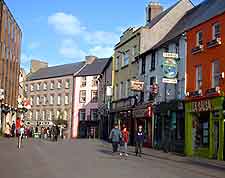
Modern Times
During the Great Famine of the mid-19th century, many people flocked to the port in a bid to escape to a better life in America. For those that were left behind, life did gradually improve. Queen's College Galway opened its doors to students in October 1849, while the railway reached the town in 1851.
At the start of 20th-century history, Galway was nothing more than a small town, with a population of around 13,000. As the century progressed, however, it started to make a slow but steady recovery. In 1985, it was awarded city status. Today, it has a reputation for being one of the fastest growing cities in Europe.
 The history of Galway can be traced back to neolithic times. Recent archaeological finds suggest that there has been human settlement on the site since then. It's also known that there has been a fort or 'dun' here since earliest times.
The history of Galway can be traced back to neolithic times. Recent archaeological finds suggest that there has been human settlement on the site since then. It's also known that there has been a fort or 'dun' here since earliest times. During the Middle Ages, Galway grew and prospered. In 1320, St. Nicholas Church was erected as its parish church. Stronger defensive walls were added at this time too. A series of charters were granted to the town, which was now also permitted to mint coins. As the years passed, Anglo-Norman culture and power dwindled and native Irish influence grew. By the 15th century, a core of Irish families - some 14 in all, had come to dominate the town's political life. Known as the Tribes of Galway, they also controlled much of the trade that took place here.
During the Middle Ages, Galway grew and prospered. In 1320, St. Nicholas Church was erected as its parish church. Stronger defensive walls were added at this time too. A series of charters were granted to the town, which was now also permitted to mint coins. As the years passed, Anglo-Norman culture and power dwindled and native Irish influence grew. By the 15th century, a core of Irish families - some 14 in all, had come to dominate the town's political life. Known as the Tribes of Galway, they also controlled much of the trade that took place here.
 Such relative peace and prosperity was to be interrupted during the 17th century. From 1651 to 1652, the town came under a long siege. For those trapped within the town, life was hard, with food supplies running low and disease rife. When the townsfolk were eventually made to surrender, its Catholic inhabitants were forced to move out. Galway's most powerful families lost their grand town houses and, in terms of influence, became a shadow of their former selves. It was to take another century to claw back the town's lost wealth.
Such relative peace and prosperity was to be interrupted during the 17th century. From 1651 to 1652, the town came under a long siege. For those trapped within the town, life was hard, with food supplies running low and disease rife. When the townsfolk were eventually made to surrender, its Catholic inhabitants were forced to move out. Galway's most powerful families lost their grand town houses and, in terms of influence, became a shadow of their former selves. It was to take another century to claw back the town's lost wealth.